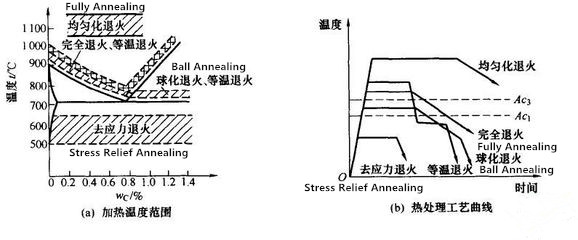Annealing is a heat treatment process for metal, slowly heated the metal to a certain temperature and maintain a sufficient time, and then cooling at an appropriate rate. The purpose for annealing is to improve or eliminate defects in various tissues and prevent deformation of the work piece or cracking. Also, annealing can be used for softening the metal for machining. Besides, it helps to grain refinement to improve the organization in order to improve the mechanical properties of the work piece. It is the preparation process for the final heat treatment (quenching and tempering).
There are different types of annealing process, these process are:
1.Fully Annealing (For refinement and low carbon steel). During the steel casing, forging and welding, the steel appreas poor mechanical properties. During fully annealing, the steel work piece is heated to a temperature above 30~50 degree, and then all the ferrite turn into austenite. Holding for some time, and then slowly cooled with the furnace. In the cooling process, austenite transformed again which make the steel organization thinner.
2.Ball Annealing. In order to reduce the high hardness of the steel after forging. The work piece is heated to a temperature between 20 to 40 degrees which the steel of austenite begins to form, and then slowly cooling after incubation. During the cooling, the lamellarpearlite cementite becomes spherical which will reduces the hardness of the steel.
3.Isothermal Annealing. In order to reduce the high hardness, high chromium content and some nickel content alloy structural steel before cutting, Isothermal Annealing is necessary. First, cooled the steel at a faster rate to the most unstable austenite temperature, and then hold the temperature for a appropriate time. In the last, the austenite turned into sorbite prop’s body which can reduce the hardness of the steel.
4.Re-crystalization Annealing. The purpose for re-crystalization annealing is to eliminate metal wire and sheet metal hardness during the cold drawing or cold rolling process (hardness increased plasticity decrease) . The heating temperature is generally between 50~150 degree which the austenitic begins to form. This is the only way to eliminate the effect of hardening and make the steel softened.
5.Graphitization Annealing. To make the cast iron contains a lot of cementite into plastic good malleable iron. The casting process operation is heated to about 950 degree. Before cooling needed to hold to a certain temperature for a certain time. In the end, the cementite decomposes to form group flocculent graphite.
6.Diffusion Annealing. It is applied on alloy castings fro the chemical composition uniformity and improves its performance. The method is applied when the meting does not occure under the premise, the casting is heated to a temperature as high as possible, and prolonged heat until alloy of various elements diffusion after slow cooling more uniform distribution.
7.Stress Relief Annealing. The purpose of Stress Relief Annealing is to eliminate the stress of steel castings and weldments. After the start of heating for the formation of austenite steel prodcuts below the temperature 100 to 200 degree and after holding cooling in the air for a certain time, you can eliminate stress of the steel.


